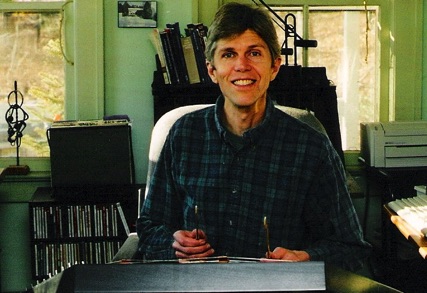* * *
* * *
* * *
The Work of Healing
September 5, 2000, for Jud Trapnell (1954-2003)

It was a foggy, muggy morning here, the usual quietness of this beloved hillside deepened by the layers of mist draped like gauze over everything. It was a good morning to dwell with the news of my best friend Jud’s cancer—“good news,” he proclaimed in his email, that only two of the lymph nodes they removed were cancerous. This "good news" shook me more than the original lump they removed some weeks ago. I guess my own denial took the form of assuming that this latest surgery to remove nearby lymph nodes was merely precautionary and that there would be no further evidence of cancer. (After writing that sentence, I sat back and cried. My anger takes the form of wanting to give Jud a hug and wishing he hadn't just moved to Minnesota.)
So I went for an early morning walk up the wooded ridge to the spot we call “High Point” and listened to what the hillside had to say. Call it the form that, for now, my acceptance takes. The work of healing is always also the work of grieving, just as letting go is integral to loving, and the stages of grief are not sequential or linear; they are patterns of emotion to which we give ourselves in layers and depths and complicated rhythms, provisional, dissipative, evolving, the spirit dancing in them like a firebird.
And then the slugs. I noticed them first on the trunk of a tulip poplar just off the trail, slugs of every size and color parading up the trunk in motionless pageantry, and suddenly I could see that slugs were everywhere, on every tree trunk and every stone of the old stone walls, on the chips of wood on the wood-chipped path. And the slugs in their sticky travels and the gossamer webs in their fleeting intricacy reminded me this morning that disease and healing are just names for one thing: the comedy of survival, the entangled bank, the big dance, the way the spirit flows through dissipative structures— structures (like a thought, a web, a body, a family, a planet) whose order and beauty are generated, fired, made available by the dying that they are also doing now.
Thus the work of healing must be, I think, the work of letting go of categories, over and over again in every moment— sickness, health, benign, malignant--in order to see that all that happens in this creative mess is good. (Let’s be clear: People can do evil things out of unhappiness and fear. But our bodies do not willfully harm us.) Everything that’s happening here is good. We are required to perform a feat of balance that our ancestors even a few generations back did not have to worry about: to recognize that medical science, which depends on categories to provide its limited but powerful and indispensable forms of intervention, is only a part (in truth a relatively small part) of the work of healing. What a difficult and courageous thing to do: to follow the doctor’s advice and believe in it, while at the same time letting go and affirming that there is no battle to be won here, that wholeness is happening unconditionally, here and now.
Practically speaking, a life that is vowed to simplicity, appropriate boldness, good humor, gratitude, unstinting work and play, and lots of walking brings us close to the actually existing world and its wholeness.
Gary Snyder, "The Etiquette of Freedom"
And that's the first thing the hillside reminded me of this morning: that there is no end to this journey. There is no "outcome." Whatever happens will happen, and it will express, one way or another, the incredible power of love that is there in EVERY cell (the “good” ones and the “bad” ones). It has been raining here for two weeks— one of those spells of endless humidity that leaves shoes in the closet covered with green mold, turns solid objects into sponges, and makes a walk in the woods feel like a journey through a rainforest. This morning, up at High Point, there were cobwebs— not the typical two-dimensional ones but three-dimensional pockets or bubbles— as delicate as wisps of cloud— tatters left behind on the dead stems of the garlic mustard, the wineberry vines, up in the branches of a dead dogwood, down in the ivy— each one an intricate, evanescent universe woven by a slender almost invisible spider. Is this all the work of one night? I don't remember seeing them before. Or did the morning mists cast over these delicate creations a spell of dewdrop and pearl light that made suddenly visible what was there all along?